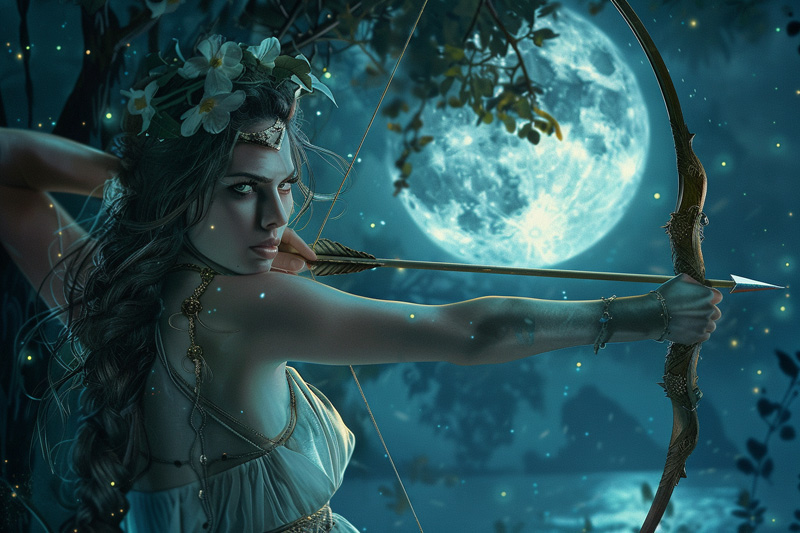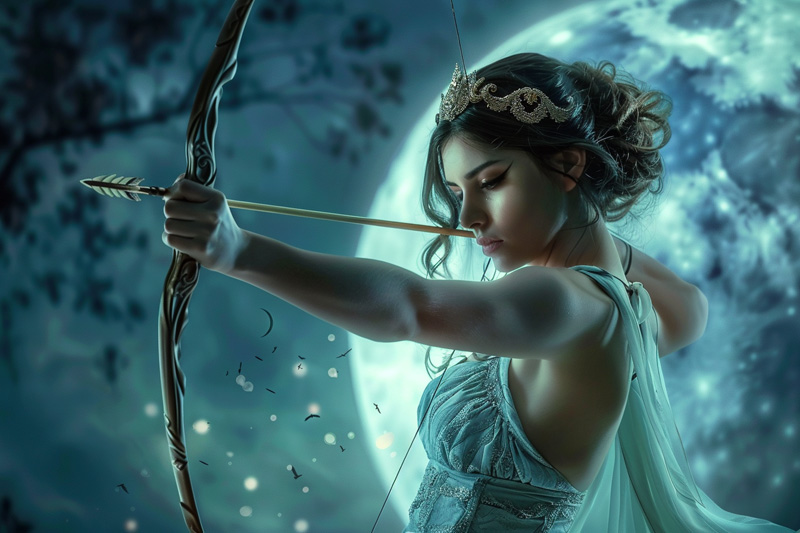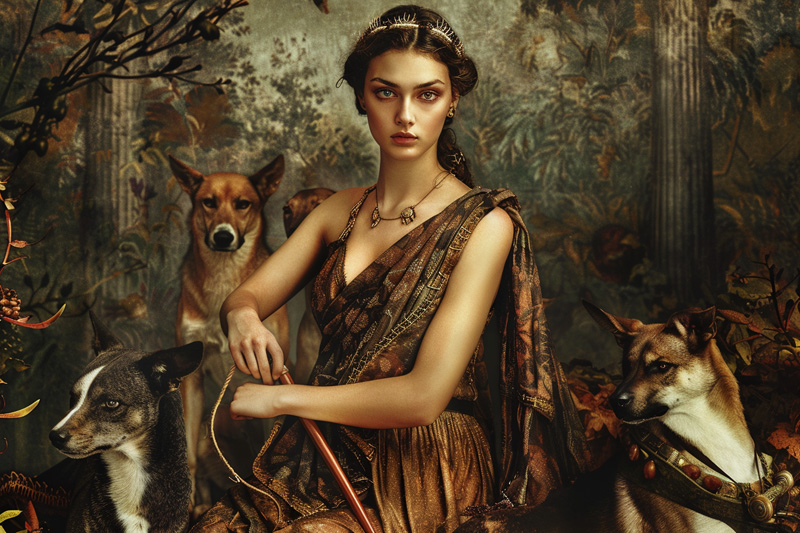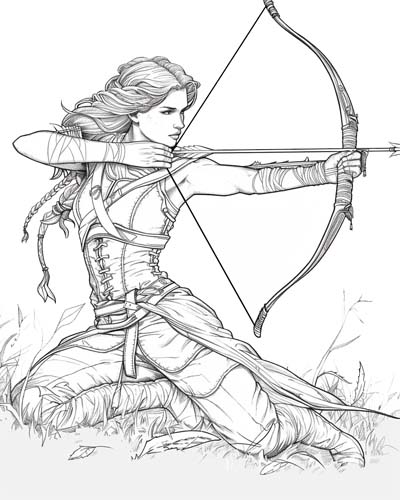KidZone Geography: Greek Mythology
About Artemis, Goddess of the Hunt and Moon
Introduction to Artemis
Artemis, one of the twelve Olympian deities in Greek mythology, is the goddess of the hunt, wilderness, moon, and childbirth. Known for her independence and strength, Artemis is often depicted with a bow and arrows, accompanied by wild animals. She is a protector of women and children and is associated with the natural world and the lunar cycle.

Quick Facts About Artemis
What is Artemis the Greek goddess of?
Artemis is the Greek goddess of the hunt, wilderness, moon, and childbirth. She governs the natural world and is a guardian of young women and children.
What are Artemis's sacred animals?
Artemis's sacred animals include the deer and the bear. The deer symbolizes her connection to the hunt and the wilderness, while the bear represents her strength and maternal instincts.

What are Artemis's symbols?
Artemis's primary symbols are the bow and arrows, the crescent moon, and the cypress tree. The bow and arrows represent her prowess as a huntress, the crescent moon signifies her lunar aspect, and the cypress tree symbolizes immortality and mourning.
Origins and Birth
Birth on Delos
Artemis is the daughter of Zeus and Leto and the twin sister of Apollo. Hera, jealous of Leto, forbade her from giving birth on solid ground. Leto found refuge on the floating island of Delos, where she gave birth to Artemis and her brother Apollo. Artemis is said to have been born first and assisted in the birth of Apollo, establishing her role as a protector of childbirth.
Artemis's Role in Greek Mythology
Goddess of the Hunt and Wilderness
Artemis's primary role is as the goddess of the hunt and wilderness. She roams the forests and mountains, accompanied by her nymphs and wild animals. As a huntress, she is known for her precision and skill with the bow and arrow.
Goddess of the Moon

Artemis is also associated with the moon and lunar cycles. She is often depicted with a crescent moon above her head, symbolizing her influence over the night and her connection to the rhythms of nature.
Protector of Women and Children
Artemis is a protector of women and children, particularly young girls. She is invoked during childbirth to ensure a safe delivery and is seen as a guardian of innocence and purity.
Iconography and Symbols

The Bow and Arrows
The bow and arrows are Artemis's most recognizable symbols, representing her role as the goddess of the hunt. She is often depicted with these weapons, emphasizing her skill and independence.
The Crescent Moon
The crescent moon symbolizes Artemis's connection to the lunar cycle and the night. It represents her influence over the natural world and her role as a protector of women.
The Cypress Tree
The cypress tree is associated with Artemis and symbolizes immortality and mourning. It is often found in sacred groves dedicated to her.
Major Myths Involving Artemis
The Myth of Actaeon
One of the most famous myths involving Artemis is the story of Actaeon. While hunting, Actaeon stumbled upon Artemis bathing in a secluded pool. Enraged by his intrusion, Artemis transformed him into a stag, and he was torn apart by his own hunting dogs.
The Tale of Orion
Artemis had a close relationship with the giant hunter Orion. There are various versions of their story, but in one, Artemis accidentally killed Orion, either by mistake or through the manipulation of Apollo. Stricken with grief, she placed him among the stars as the constellation Orion.
The Calydonian Boar Hunt
Artemis sent a monstrous boar to ravage the land of Calydon as punishment for being neglected in offerings. A group of heroes, including Atalanta and Meleager, set out to hunt the boar. The hunt ended in the boar's death and sparked a conflict over the prize, leading to further tragedy.
Artemis's Relationships and Offspring

Virgin Goddess
Artemis is known as a virgin goddess, committed to chastity and independence. Unlike other Olympian deities, she did not marry or have children, focusing instead on her role as a huntress and protector.
Relationships with Nymphs
Artemis was accompanied by a group of nymphs, who were also committed to chastity. These nymphs served as her companions and assistants in the hunt. One notable nymph was Callisto, who was transformed into a bear by Hera and later placed in the sky as the constellation Ursa Major.
Worship and Cult of Artemis

Temples and Sanctuaries
Artemis was worshipped throughout ancient Greece, with many temples and sanctuaries dedicated to her. The most famous of these is the Temple of Artemis at Ephesus, one of the Seven Wonders of the Ancient World. Another significant site is the Sanctuary of Artemis Brauronia in Athens, where young girls participated in rituals to honor her.
Festivals and Rituals
Several festivals celebrated Artemis's influence over the hunt, wilderness, and childbirth. The most notable of these is the Brauronia, held every four years in her honor. This festival included rituals, dances, and sacrifices, with young girls participating in rites of passage. Another important festival is the Artemisia, celebrated in various regions to honor her role as the goddess of the hunt.
Artemis in Art and Literature

Classical Depictions
In classical art, Artemis is often depicted as a youthful, athletic figure with a bow and arrows. She is frequently shown in the company of animals, emphasizing her connection to the natural world.
Renaissance and Beyond
During the Renaissance, artists like Titian and Caravaggio drew inspiration from classical depictions of Artemis, incorporating her into their works. Titian's painting "Diana and Actaeon" and Caravaggio's "Rest on the Flight into Egypt" highlight her beauty and power.
Modern Interpretations
In modern times, Artemis continues to be a prominent figure in literature, film, and popular culture. She appears in various forms, from comic books and movies to television series and video games. These contemporary portrayals often explore different aspects of her character, from her independence and strength to her role as a protector. In the Percy Jackson series, for example, Artemis is depicted as a fierce and dedicated goddess, reflecting modern interpretations of her myth.
Conclusion
Artemis remains one of the most dynamic figures in Greek mythology. Her role as the goddess of the hunt, wilderness, moon, and childbirth, combined with her complex personality and significant myths, make her a fascinating character. As the embodiment of independence, strength, and natural beauty, Artemis's influence extends across the divine and mortal realms. Her enduring impact can be seen in the continued fascination with her myths and the artistic representations that keep her legend alive. Through her worship, iconography, and the rich tapestry of stories that surround her, Artemis exemplifies the power and complexity of ancient Greek religion and mythology.

